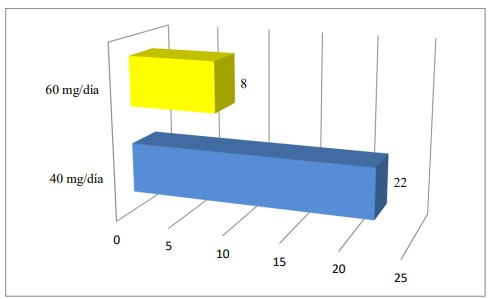Early thromboprophylaxis and evolution in pregnant women with COVID-19
Main Article Content
Abstract
Introduction: in March 2020, a Pandemic was declared, due to the appearance of a new Coronavirus, SARS-CoV2 (COVID-19). Pregnant women have a higher risk of presenting thromboembolic processes, so it is recommended to use heparin prophylactically, to prevent thromboembolic processes during SARS-CoV2 infection.
Objective: to describe the evolution of pregnant women with SARS-CoV2 infection with the early use of Enoxaparin, adjusted to the weight of low molecular weight heparin.
Methodology: prospective, observational, cross-sectional descriptive study.
Results: in the evolution of 30 pregnant women with SARS-CoV2 infection, the most frequent ages correspond to 31 to 35 years, the highest number of infected in the second trimester of pregnancy, the predominant body mass index in the range of overweight and obesity. , the dose of enoxaparin used was 40 mg/day, since it was adjusted to the weight of the pregnant woman, the most frequent comorbidities were overweight and obesity, hypertensive disease of pregnancy and gestational
diabetes, the symptoms were highly varied, due to the different variants of the virus, more frequently rhinorrhea, nasal congestion, cough, anosmia, dysgeusia, headache, fever and respiratory distress, and most of the pregnant women were not vaccinated.
Conclusions: none of the 30 pregnant women who received low molecular weight heparin (Enoxapine), adjusted for weight, and early, with SARS.CoV2 infection, died or required admission to the Intensive Care Unit. A pregnant woman was hospitalized due to moderate dyspnea and oxygen saturation less than 95%. The remaining pregnant women had a good evolution at home, without any complications.
Article Details

This work is licensed under a Creative Commons Attribution 4.0 International License.
References
Green A. Li Wenliang. Lancet. 2020; 395(1025): 682. Disponible en: https://www.thelancet.com/pdfs/journals/lancet/PIIS0140-6736(20)30382-2.pdf2.
Organización Panamericana de la Salud / Organización Mundial de la Salud. Actualización epidemiológica: enfermedad por Coronavirus (COVID-19). 11 de marzo de 2021, Washington, D.C.: OPS/OMS; 2021. Disponible en: https://iris.paho.org/bitstream/handle/10665.2/53381/EpiUpdate11March2021_spa.pdf?sequence=2&isAllowed=y
Chuan Q, Luoqi Z, Ziwei H, Shuoqi Z, Sheng Y, Yu T, et al. Dysregulation of immune response in patients with coronavirus 2019 (COVID-19) in Wuhan, China. Clinical Infectious Diseases. 2020 [citado 20/04/2020]; 20 (20): 1-7. Disponible en: https://academic.oup.com/cid/article/doi/10.1093/cid/ciaa248/5803306
Mehta P, McAuley DF, Brown M, Sanchez E, Tattersall RS, Manson JJ, et al. COVID-19: consider cytokine storm syndromes and immunosuppression. Lancet. 2020; 395(10229): 1033-4
Sociedad Española de Trombosis y Hemostasia (Versión 2). Recomendaciones sobre profilaxis de enfermedad
tromboemblica (ETV) en el embarazo y puerperio durante la pandemia COVID-19. 2022. Disponible en: https://www.seth.es/images/publicaciones/Recomendaciones-sobre-profilaxis-ETV-en-embarazo-y-puerperio-COVID-19.pdf
Sociedad Paraguaya de Hematología y Medicina Transfusional. Recomendaciones de profilaxis y tratamiento antitrombótico en pacientes con enfermedad por SARS-CoV-2 (COVID-19): consenso. Asunción: SPHYMT, 2020. 8 p.
Organización Panamericana de la Salud/Organización Mundial de la Salud. Alerta Epidemiológica: COVID-19 en el embarazo, 13 de agosto de 2020, Washington, D.C. OPS/OMS. 2020
Thachil J, Tang N, Gando S, Falanga A, Cattaneo M, Levi M, et al. ISTH interim guidance on recognition and management of coagulopathy in COVID-19. J Thromb Haemost. 2020;18(5):1023-1026. doi: 10.1111/jth.14810
Bikdeli B, Madhavan MV, Jimenez D, Chuich T, Dreyfus I, Driggin E, et al. COVID-19 and thrombotic or thromboembolic disease: implications for prevention, antithrombotic therapy, and follow-up. J Am Coll Cardiol. 2020;75(23):2950-2973. doi: 10.1016/j.jacc.2020.04.031
Li J, Li Y, Yang B, Wang H, Li L. Low-molecular-weight heparin treatment for acute lung injury /acute respiratory distress syndrome: a meta-analysis of randomized controlled trials. Int J Clin Exp Med. 2018;11(2):414-422.
Mousavi S, Moradi M, Khorshidahmad T, Motamedi M. Anti-inflammatory effects of heparin and its derivatives: a systematic review. Adv Pharmacol Sci. 2015;2015:507151
Pitilin EB, Lentsck MH, Gasparin VA, Falavina LP, Conceição VM, Oliveira PP, et al. COVID em mulheres no Brasil: tempo de permanência e status das primeiras internações. Rev. Rene. 2021;22: e61049. doi: 10.15253/2175-6783.20212261049
Knight M, Bunch K, Vousden N, Morris E, Simpson N, Gale C, et al. Characteristics and outcomes of pregnant women admitted to hospital with confirmed SARS-CoV-2 infection in UK: national population-based cohort study. BMJ. 2020;369:m2107. doi: 10.1136/bmj.m2107
República del Paraguay. Ministerio de Salud Pública y Bienestar Social. Guía para el manejo de mujeres embarazadas y eventos obstétricos: protocolo para COVID-19. 2ª. versión. Asunción: El Ministerio, 2021. Disponible en: https://www.mspbs.gov.py/dependencias/portal/adjunto/24afa4-PROTOCOLOPARACOVID19GUIAPARAELMANEJODEMUJERESEMBARAZADASYEVENTOSOBSTETRICOS.pdf
